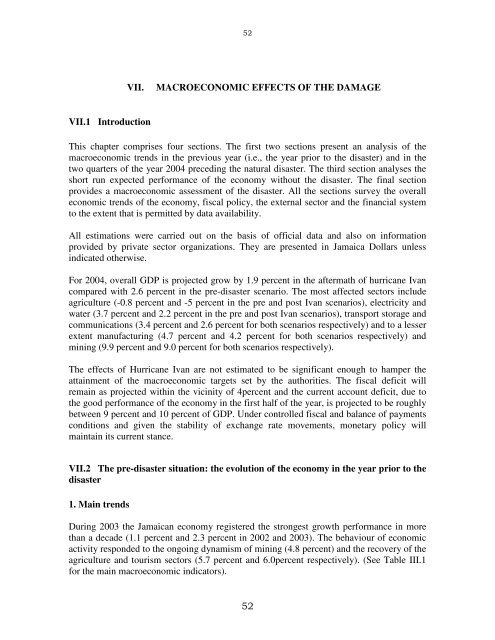Jamaica: Macro-Socio-Economic and Environmental Assessment of ...
Jamaica: Macro-Socio-Economic and Environmental Assessment of ...
Jamaica: Macro-Socio-Economic and Environmental Assessment of ...
Create successful ePaper yourself
Turn your PDF publications into a flip-book with our unique Google optimized e-Paper software.
52<br />
VII.<br />
MACROECONOMIC EFFECTS OF THE DAMAGE<br />
VII.1 Introduction<br />
This chapter comprises four sections. The first two sections present an analysis <strong>of</strong> the<br />
macroeconomic trends in the previous year (i.e., the year prior to the disaster) <strong>and</strong> in the<br />
two quarters <strong>of</strong> the year 2004 preceding the natural disaster. The third section analyses the<br />
short run expected performance <strong>of</strong> the economy without the disaster. The final section<br />
provides a macroeconomic assessment <strong>of</strong> the disaster. All the sections survey the overall<br />
economic trends <strong>of</strong> the economy, fiscal policy, the external sector <strong>and</strong> the financial system<br />
to the extent that is permitted by data availability.<br />
All estimations were carried out on the basis <strong>of</strong> <strong>of</strong>ficial data <strong>and</strong> also on information<br />
provided by private sector organizations. They are presented in <strong>Jamaica</strong> Dollars unless<br />
indicated otherwise.<br />
For 2004, overall GDP is projected grow by 1.9 percent in the aftermath <strong>of</strong> hurricane Ivan<br />
compared with 2.6 percent in the pre-disaster scenario. The most affected sectors include<br />
agriculture (-0.8 percent <strong>and</strong> -5 percent in the pre <strong>and</strong> post Ivan scenarios), electricity <strong>and</strong><br />
water (3.7 percent <strong>and</strong> 2.2 percent in the pre <strong>and</strong> post Ivan scenarios), transport storage <strong>and</strong><br />
communications (3.4 percent <strong>and</strong> 2.6 percent for both scenarios respectively) <strong>and</strong> to a lesser<br />
extent manufacturing (4.7 percent <strong>and</strong> 4.2 percent for both scenarios respectively) <strong>and</strong><br />
mining (9.9 percent <strong>and</strong> 9.0 percent for both scenarios respectively).<br />
The effects <strong>of</strong> Hurricane Ivan are not estimated to be significant enough to hamper the<br />
attainment <strong>of</strong> the macroeconomic targets set by the authorities. The fiscal deficit will<br />
remain as projected within the vicinity <strong>of</strong> 4percent <strong>and</strong> the current account deficit, due to<br />
the good performance <strong>of</strong> the economy in the first half <strong>of</strong> the year, is projected to be roughly<br />
between 9 percent <strong>and</strong> 10 percent <strong>of</strong> GDP. Under controlled fiscal <strong>and</strong> balance <strong>of</strong> payments<br />
conditions <strong>and</strong> given the stability <strong>of</strong> exchange rate movements, monetary policy will<br />
maintain its current stance.<br />
VII.2 The pre-disaster situation: the evolution <strong>of</strong> the economy in the year prior to the<br />
disaster<br />
1. Main trends<br />
During 2003 the <strong>Jamaica</strong>n economy registered the strongest growth performance in more<br />
than a decade (1.1 percent <strong>and</strong> 2.3 percent in 2002 <strong>and</strong> 2003). The behaviour <strong>of</strong> economic<br />
activity responded to the ongoing dynamism <strong>of</strong> mining (4.8 percent) <strong>and</strong> the recovery <strong>of</strong> the<br />
agriculture <strong>and</strong> tourism sectors (5.7 percent <strong>and</strong> 6.0percent respectively). (See Table III.1<br />
for the main macroeconomic indicators).<br />
52
















